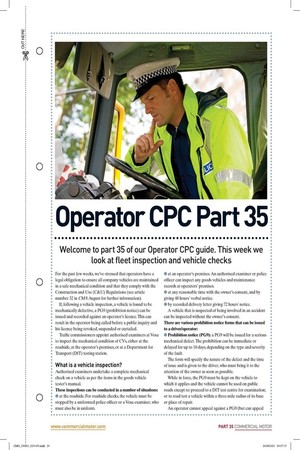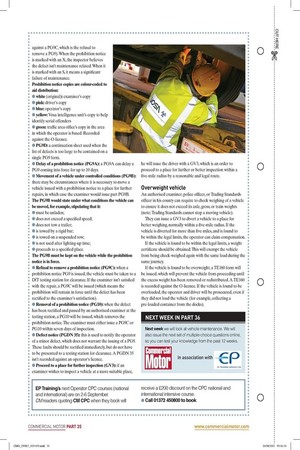Operator CPC Part 35 Welcome to part 35 of our
Page 23

Page 24

If you've noticed an error in this article please click here to report it so we can fix it.
Operator CPC guide. This week we look at fleet inspection and vehicle checks
For the past few weeks, we've stressed that operators have a legal obligation to ensure all company vehicles are maintained in a safe mechanical condition and that they comply with the Construction and Use (C&U) Regulations (see article number 32 in CM8 August for further information).
If following a vehicle inspection, a vehicle is found to be mechanically defective, a PG9 (prohibition notice) can be issued and recorded against an operator's licence. This can result in the operator being called before a public inquiry and his licence being revoked, suspended or curtailed.
Traffic commissioners appoint authorised examiners at Vosa to inspect the mechanical condition of CVs, either at the roadside, at the operator's premises, or at a Department for Transport (DfT) testing station.
What is a vehicle inspection?
Authorised examiners undertake a complete mechanical check on a vehicle as per the items in the goods vehicle tester's manual. These inspections can be conducted in a number of situations:
• at the roadside. For roadside checks, the vehicle must be stopped by a uniformed police officer or a Vosa examiner, who must also be in uniform.
• at an operator's premises. An authorised examiner or police officer can inspect any goods vehicles and maintenance records at operators' premises.
• at any reasonable time with the owner's consent, and by giving 48 hours' verbal notice.
• by recorded delivery letter giving 72 hours' notice. A vehicle that is suspected of being involved in an accident can be inspected without the owner's consent. There are various prohibition notice forms that can be issued to a driver/operator:
• Prohibition notice (PG9): a PG9 will be issued for a serious mechanical defect. The prohibition can be immediate or delayed for up to 10 days, depending on the type and severity of the fault.
The form will specify the nature of the defect and the time of issue and is given to the driver, who must bring it to the attention of the owner as soon as possible.
While in force, the PG9 must be kept on the vehicle to which it applies and the vehicle cannot be used on public roads except to: proceed to a DfT test centre for examination; or to road test a vehicle within a three-mile radius of its base or place of repair. An operator cannot appeal against a PG9 (but can appeal
against a PG9C, which is the refusal to remove a PG9). When the prohibition notice is marked with an X, the inspector believes the defect isn't maintenance related. When it is marked with an S, it means a significant failure of maintenance. Prohibition notice copies are colour-coded to aid distribution: • white (original): examiner's copy • pink: driver's copy • blue: operator's copy • yellow: Vosa intelligence unit's copy to help identify serial offenders
• green: traffic area office's copy in the area in which the operator is based. Recorded against the 0-licence.
• PG9D: a continuation sheet used when the list of defects is too large to be contained on a single PG9 form. • Delay of a prohibition notice (PG9A): a PG9A can delay a
PG9 coming into force for up to 10 days. • Movement of a vehicle under controlled conditions (PG9B): there may be circumstances where it is necessary to move a vehicle issued with a prohibition notice to a place for further repairs, in which case the examiner would issue part PG9B. The PG9B would state under what conditions the vehicle can be moved, for example, stipulating that it: • must be unladen; • does not exceed a specified speed; • does not tow a trailer; • is towed by a rigid bar; • is towed on a suspended tow; • is not used after lighting-up time;
• proceeds to a specified place.
The PG9B must be kept on the vehicle while the prohibition notice is in force.
• Refusal to remove a prohibition notice (PG9C): when a prohibition notice PG9 is issued, the vehicle must be taken to a DfT testing station for clearance. If the examiner isn't satisfied with the repair, a PG9C will be issued (which means the prohibition will remain in force until the defect has been rectified to the examiner's satisfaction). • Removal of a prohibition notice (PG10): when the defect has been rectified and passed by an authorised examiner at the testing station, a PG10 will be issued, which removes the prohibition notice. The examiner must either issue a PG9C or
PG10 within seven days of inspection.
• Defect notice (PGDN 35): this is used to notify the operator of a minor defect, which does not warrant the issuing of a PG9. These faults should be rectified immediately, but do not have to be presented to a testing station for clearance. A PGDN 35 isn't recorded against an operator's licence. • Proceed to a place for further inspection (GV3): if an examiner wishes to inspect a vehicle at a more suitable place,
he will issue the driver with a GV3, which is an order to proceed to a place for further or better inspection within a five-mile radius by a reasonable and legal route. Overweight vehicle
An authorised examiner, police officer, or Trading Standards officer in his county can require to check weighing of a vehicle to ensure it does not exceed its axle, gross, or train weights (note: Trading Standards cannot stop a moving vehicle).
They can issue a GV3 to divert a vehicle to a place for better weighing, normally within a five-mile radius. If the vehicle is diverted for more than five miles, and is found to be within the legal limits, the operator can claim compensation.
If the vehicle is found to be within the legal limits, a weight certificate should be obtained. This will exempt the vehicle from being check-weighed again with the same load during the same journey.
If the vehicle is found to be overweight, a TE160 form will be issued, which will prevent the vehicle from proceeding until the excess weight has been removed or redistributed. A TE160 is recorded against the 0-licence. If the vehicle is found to be overloaded, the operator and driver will be prosecuted, even if they did not load the vehicle (for example, collecting a pre-loaded container from the docks).













































